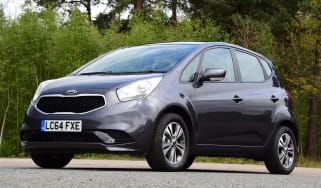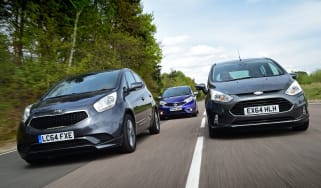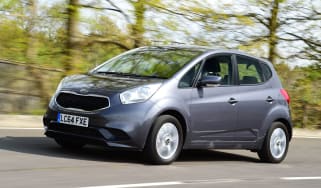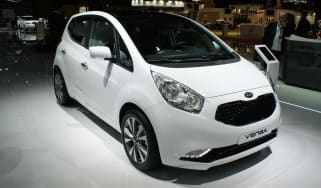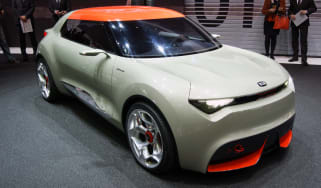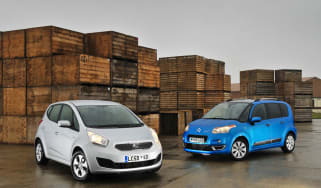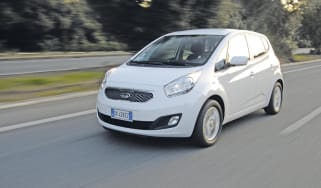Kia Venga (2010-2019) review
The Kia Venga has made a big impact in the mini MPV sector, with great space and strong value
The Kia Venga proves that you don’t need to spend a lot of money to get a truly practical family car. This supermini-sized MPV combines practicality and value for money to great effect, and as a result has made a big impact on its class.
A strong part of the appeal too, is the industry-leading seven-year warranty Kia offers –providing buyers with real peace of mind. The only potential fly in the ointment is the firm suspension, which can make for a rather uncomfortable ride over rough road surfaces.
Plus, as spacious and practical as the interior is, it trails rivals like the Honda Jazz and Ford B-MAX by a long way in terms of quality. The Venga hasn’t even caught up with the level of fit and finish found in newer cars from Kia, although a recent facelift has addressed some of the areas of concern in the cabin.
Most buyers will be able to put up with this when they look at the price, though: the basic 1 model represents brilliant value for money, while even the more expensive, gadget-packed flagship 3 looks tempting.
‘Tardis-like’ may be a bit of a cliché, but maximising cabin space was obviously first and foremost in the design team’s mind when they penned the diminutive Kia Venga’s shape.
The Venga is a mini-MPV with a very small footprint, but voluminous proportions that make for an exceptionally roomy interior. In competes in a class of rivals that includes cars like the Ford B-Max, Citroen C3 Picasso, Nissan Note and Skoda Roomster.
The model has been around for a few years now, having debuted in 2009. It’s part of a joint venture project between Kia and Hyundai, so shares a front-engined, front-wheel-drive platform with the Hyundai i20 – as well as with Kia’s related mini-SUV which is called the Soul. The Venga is built at Hyundai’s European plant at Nošovice in the Czech Republic, alongside its Hyundai sister cars.
Kia’s mini-MPV, which is only available in five-door hatchback format, has recently received a mid-life refresh in a similar way to the latest Picanto city car. The upgrade delivered tweaked exterior styling including new alloy wheels designs, a larger front grille, deeper air inlets and daytime running lights.
The Venga’s engine line up includes 1.4 and 1.6-litre petrol and diesel options, all offering relatively staid performance. Economy is good across the board, although there are plenty of newer rivals that return even better figures – as well as greater performance.
The Venga comes in six trim levels, handily numbered 1 to 4. There’s an ‘Air’ version of the Venga 1 which features air-con, plus the more youthful Bluetooth-equipped SR7 to complete the range.
The entry-level Venga 1 has ESC as standard, plus twin front, side and curtain airbags, steering wheel controls, 60:40 split rear seat, and electric front windows and mirrors. The Venga 2 adds reversing sensors, 16 inch alloy wheels all-round Bluetooth, electric windows and folding mirrors, but you need to reach Venga 3 level to get a 7-inch touchscreen nav, a reversing camera, heated seats and cruise control. The Venga 4 adds a panoramic sunroof to an expanded list of luxuries.
Engines, performance and drive
With quick, if lifeless, steering and reasonable grip, the Venga is surprisingly agile on twisting back roads.
Longer-travel suspension means there’s a noticeable amount of body roll if you’re a little too energetic with your corner entry speed, and the squidgy steering doesn’t give much feedback.
The Venga is more about relaxed cruising in urban areas than blasting down a country road. Here it makes more sense, with a soft chassis set-up that soaks up cracked roads and rutted tarmac well.
On the motorway, the Venga is refined and offers smooth cruising ability, while even on B-roads it’s comfortable, floating nicely over bumps. It never feels engaging, though, and it’s a shame that the engine lacks any real shove, even if the light five-speed manual gearbox is pleasant to use.
Engines
There’s a wide choice of engines in the Kia Venga, although matters are complicated because different trim levels have different options. Entry-level 1 models come with 1.4-litre petrol or diesel engines, both with 89bhp and a manual gearbox only, while if you go for 2 spec, you also get the option of a 123bhp 1.6-litre petrol engine with an automatic box.
Buyers choosing the top-spec Venga 3 and Venga 4 models can pick from the 123bhp 1.6-litre petrol engine with manual or automatic transmissions, or a 114bhp 1.6-litre CRDi diesel manual – and the latter is the cleanest and most economical model in the range.
In fact, diesel will be the best bet for most buyers, as the 1.4 and 1.6 CRDi engines combine stronger efficiency with decent mid-range performance, and their six-speed manual boxes serve up greater long distance refinement. Petrol 0-60mph times vary from 10.4 seconds (1.6 manual) to 12.4 seconds (1.4 manual), while the diesels do it in 11.0 seconds (1.6 manual) or 13.7 seconds (1.4 manual).
MPG, CO2 and Running Costs
If low running costs are a priority, then diesel versions of the Venga make the most sense.
The top-spec 1.6-litre CRDi diesel is equipped with stop-start technology – Kia calls this Intelligent Stop and Go, or ISG – and promises fuel consumption of only 64.2mpg, while 115g/km CO2 emissions mean low road tax bills. ISG also cuts fuel and road tax bills on the 1.4 and 1.6-litre petrol cars, which return 50.4mpg and 47.9mpg respectively. In fact the only models that don’t get ISG are cars fitted with the 1.6 petrol engine and an auto gearbox.
But you don’t have to buy a high-spec Venga to get low fuel consumption and emissions: a 1.4-litre diesel is available in the Venga 2 – not quite the cheapest version - which like its bigger brother can also deliver 64.2mpg and 115g/km on the official combined test cycle. The CRDi versions also benefit from longer, 20,000-mile service intervals; petrol versions of the Venga will need attention from your local dealer every 10,000 miles.
The Venga is relatively cheap to purchase too, of course, and the decent spec levels at each price point make the trim levels look very competitive.
Insurance groups
Given it’s unexciting performance, it’s unsurprising that the Venga line-up is not costly to insure. The model ranges from insurance group eight to 15, depending on the spec you choose.
Depreciation
The Kia Venga represents strong value for money, undercutting less well-equipped mainstream rivals on price. However, it doesn’t hold on to that price especially well and poor predicted residual values undermine the otherwise excellent financial case for this car. CAP reckons you’ll hold on to around 39 percent of the new price if you sell at three years/36,000 miles, but the SR7 special edition could drop as low as 36 percent.
If you pick one of the more expensive models, those sorts of percentages can hit you hard in the wallet.
To get an accurate valuation on a specific model check out our free car valuation tool...
Interior, design and technology
As with the recently revised Kia Picanto, it’s a game of spot the difference to tell this Venga apart from the previous model. But Kia has given its supermini-MPV a revised front-end design, with a larger version of its trademark ‘tiger nose’ grille as well as a larger lower air inlet that incorporates the Venga’s foglamps and daytime running lights.
There are a few other styling tweaks, including some new alloy wheel designs across the range, but the visual differences really are minimal – and in our test car’s £490 optional Silver Storm metallic paint, the Venga’s soft, rounded shape appeared a little drab.
The Kia’s hatchback-on-stilts looks provide clues to it versatility, and although it might not be the most stylish five-door on sale, the extra height works wonders for practicality, adding extra room inside.
Kia might not have focused too much on changing the exterior design as part of the recent facelift, as the basic look worked and the family resemblance was already present, but the interior has come in for more attention. There are now some smarter trim details that brighten up the functional layout, and although you don’t get that many tech gadgets on the lower-spec models, a tyre pressure monitor is now fitted as standard across the range. Also included on all but the entry model are core features like air-conditioning and rear parking sensors.
It’s not the most sparkling cabin, but it does feel hard-wearing and build quality is good. In this sector, where practicality rules, it’s these qualities that can make the difference. The Kia scores well here, even if it is a little short on flair.
Sat-nav, stereo and infotainment
All Venga grades get a six-speaker audio system with CD/MP3 disc compatibility, but the entry-level 1 doesn’t get Bluetooth streaming so you’ll have to rely on the USB and aux ports.
Bluetooth arrives from the Venga 2 up, while the 7-inch touchscreen sat-nav with integrated reversing camera is part of the spec on Venga 3 and 4 models.
Practicality, comfort and boot space
It might not have that much design flair, but things get a lot brighter for the Kia when it comes to designed-in practicality. The Venga has plenty of room for four adults, and an impressive boot.
Inside there are five seats, and a high seating position. This means the driver has an excellent view of the road ahead, and good vision all around while parking. There are decent-sized storage compartments in all the usual places, and there’s a handy armrest for extra comfort on long journeys.
Dimensions and size
The Kia Venga is 4,075mm long, 1,765mm wide and 1,600mm tall. This compares closely to the Ford B-Max which is within a few mm in all directions. The Nissan Note is a little longer at 4,100mm but lower at 1,530mm.
Leg room, head room & passenger space
Thanks to its upright profile the Kia Venga offers plenty of headroom in the front and rear, so four adults can travel comfortably. You get a third centre seat on the rear bench, but the laws of physics do apply and if you want to travel three-up in the back you’ll need everyone to be small, slim and on very good terms.
Practicality is further helped by a rear seat bench which can slide back and forward by up to 130mm, giving the option of decreasing rear legroom if you’ve only got small kids and a load of luggage. Isofix mountings are standard in the rear, too.
Boot space
In its default five-seat configuration, the 440-litre boot is one of the biggest around in the class – the Ford B-Max has just 318-litres when all its seats are in place. Slide the Venga’s rear bench forward and you can raise the volume to 570-litres, but that is at the expense of adult legroom.
With the back folded seats down, the Kia’s luggage capacity rises to 1,253 litres, which isn’t as big as in the Ford B-MAX at 1,386-litres, but still plenty. There’s also a false boot floor for secure storage, but what is most impressive about the Venga is that the load bay is so spacious when you’ve a car full of passengers.
Reliability and Safety
Compared to some of its rivals, the new updated Venga should also be reassuring to run, as Kia finished our Driver Power 2015 satisfaction survey in 19th position. This isn’t the best performance out of 30 or so manufacturers, but its Reliability scores were more impressive.
The brand’s dealer network fared much better, coming in 10th place in our latest survey. The result implies that if something does go wrong, you’ve a good chance of getting your issue resolved in a satisfactory fashion.
We’ve not heard of any major problems with the Venga itself, but the pre-facelift version only just made our Driver Power top 200 best cars to live with – owners ranked it 197th. The model scored a solid mid-table 103rd for Reliability, whereas Build Quality was right down at 198th. It’s pleasing therefore to be able to report that the facelift addressed some of those interior quality issues from early cars.
Euro NCAP crash tested the previous Venga in 2010, and although it performed well by scoring a full five-star rating, the assessment has changed since then. Still, we’d expect the new car to fare as well now, with six airbags and ESP as standard. The Euro NCAP scores were 89 per cent for adult occupants, 85 per cent for children and 64 per cent for pedestrians. The Ford B-Max scores 92/84/67 per cent across the same categories, while the Nissan Note scores 86/82/58 percent.
The Venga’s roster of safety kit includes a hill start assist function, plus tyre pressure monitoring, and the car will flash the hazard lights under hard braking to warn drivers behind.
Warranty
The Kia brand offers a market leading warranty here in the UK, covering its vehicles for an impressive seven years with unlimited mileage. Hyundai and Chevrolet are the next closest rivals offering five-year cover, the former with unlimited mileage, the latter with a 100,000-mile cap. The Ford B-Max and Nissan Note both have three-year cover with a 60,000-mile cap.
Servicing
Services are required annually or at 20,000 miles for diesel cars or 10,000 miles for petrol. Costs should be very competitive, as the brand is at the budget end of the market.


